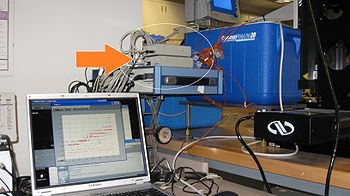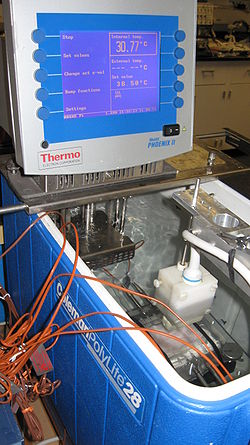Difference between revisions of "The Experimental Setup"
ChuckHolmes (talk | contribs) |
ChuckHolmes (talk | contribs) |
||
| Line 1: | Line 1: | ||
| − | The methods of this work involved the measurement of temperature and synchronous ultrasonic imaging of tissue in a water bath. The tissue was usually a piece of turkey purchased from a local grocery store or a piece of preserved rabbit liver. The tissue was placed in experimental housing as seen in Figure 1. This housing was then placed in a water bath in an insulated container, as seen in Figure 2. | + | The methods of this work involved the measurement of temperature and synchronous ultrasonic imaging of tissue in a water bath. The tissue was usually a piece of turkey purchased from a local grocery store or a piece of preserved rabbit liver. The tissue was placed in experimental housing as seen in Figure 1. This housing was then placed in a water bath in an insulated container, as seen in Figure 2. There are four main components to the experiment, all of which interface with each other via a MATLAB script. The components include: 1) the DATAQ, which acquires temperature data, 2) the ThermoHaake, heats and circulates the water bath, 3) the ultrasound transducer, which acquires ultrasonic images of the tissue, and 4) the Newport, which is a mechanical actuator which moves the ultrasound transducer so it can take pictures of multiple slices of tissue. The DATAQ, ThermoHaake, and Newport are all named after the makes or models of the device. |
[[File:Housing.jpg|350px]] | [[File:Housing.jpg|350px]] | ||
| Line 7: | Line 7: | ||
<br>'''Figure 2 - The housing placed in the heated water bath'''<br><br> | <br>'''Figure 2 - The housing placed in the heated water bath'''<br><br> | ||
| − | + | ===DATAQ and Temperature Data Acquisition=== | |
| − | + | Seen in Figure 2 are thermocouples inserted into the tissue. A clearer view of the thermocouples can be seen in Figure 3. These thermocouple attached to a DATAQ device, seen in Figure 4. This device is used to acquire temperature data from multiple (up to 8) channels via thermocouple. | |
A second device used in the experiment is the ThermoHaake (the device with the screen as seen in Figure 5). This device has 3 purposes: 1) Heat the water bath, 2) Circulate the water bath, and 3) Measure the temperature of the water bath. | A second device used in the experiment is the ThermoHaake (the device with the screen as seen in Figure 5). This device has 3 purposes: 1) Heat the water bath, 2) Circulate the water bath, and 3) Measure the temperature of the water bath. | ||
| Line 16: | Line 16: | ||
The water bath is circulated by a pumping filtration system. In the same complex as the heating coils are an incoming and an outgoing pump. This system takes up water from the bath, filters the water, and then deposits the water back into the bath. This mechanism circulates the bath such that the water is in constant motion. By circulating the water, the ensures that the water bath heating will be very nearly uniform. | The water bath is circulated by a pumping filtration system. In the same complex as the heating coils are an incoming and an outgoing pump. This system takes up water from the bath, filters the water, and then deposits the water back into the bath. This mechanism circulates the bath such that the water is in constant motion. By circulating the water, the ensures that the water bath heating will be very nearly uniform. | ||
| − | The water bath temperature is measured by a third component of the complex under the ThermoHaake. This device is a thermistor that measure the sample of water below the ThermoHaake, but this sample is treated as representative of the entire water bath, especially because of the circulation. The thermistor is also treated as the "truth" for temperature measurement, that is to say that it is treated as having zero error in its measurement. | + | The water bath temperature is measured by a third component of the complex under the ThermoHaake. This device is a thermistor that measure the sample of water below the ThermoHaake, but this sample is treated as representative of the entire water bath, especially because of the circulation. The thermistor is also treated as the "truth" for temperature measurement, that is to say that it is treated as having zero error in its measurement. |
This system measures the temperature in the tissue from 4 different channels and at the same time measures temperature from two points in the water bath. | This system measures the temperature in the tissue from 4 different channels and at the same time measures temperature from two points in the water bath. | ||
Revision as of 07:15, 12 May 2011
The methods of this work involved the measurement of temperature and synchronous ultrasonic imaging of tissue in a water bath. The tissue was usually a piece of turkey purchased from a local grocery store or a piece of preserved rabbit liver. The tissue was placed in experimental housing as seen in Figure 1. This housing was then placed in a water bath in an insulated container, as seen in Figure 2. There are four main components to the experiment, all of which interface with each other via a MATLAB script. The components include: 1) the DATAQ, which acquires temperature data, 2) the ThermoHaake, heats and circulates the water bath, 3) the ultrasound transducer, which acquires ultrasonic images of the tissue, and 4) the Newport, which is a mechanical actuator which moves the ultrasound transducer so it can take pictures of multiple slices of tissue. The DATAQ, ThermoHaake, and Newport are all named after the makes or models of the device.
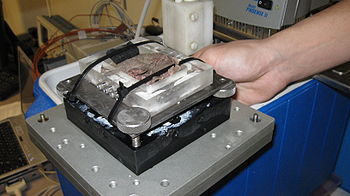
Figure 1 - The tissue placed in it experimental housing
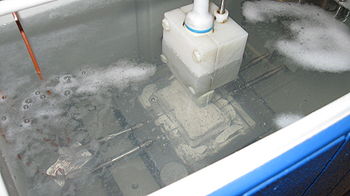
Figure 2 - The housing placed in the heated water bath
DATAQ and Temperature Data Acquisition
Seen in Figure 2 are thermocouples inserted into the tissue. A clearer view of the thermocouples can be seen in Figure 3. These thermocouple attached to a DATAQ device, seen in Figure 4. This device is used to acquire temperature data from multiple (up to 8) channels via thermocouple.
A second device used in the experiment is the ThermoHaake (the device with the screen as seen in Figure 5). This device has 3 purposes: 1) Heat the water bath, 2) Circulate the water bath, and 3) Measure the temperature of the water bath.
The water bath is heated by heating coils on the underside of the ThermoHaake. This heating system is used to bring the water temperature from 36 degrees Celsius to 70 degrees Celsius.
The water bath is circulated by a pumping filtration system. In the same complex as the heating coils are an incoming and an outgoing pump. This system takes up water from the bath, filters the water, and then deposits the water back into the bath. This mechanism circulates the bath such that the water is in constant motion. By circulating the water, the ensures that the water bath heating will be very nearly uniform.
The water bath temperature is measured by a third component of the complex under the ThermoHaake. This device is a thermistor that measure the sample of water below the ThermoHaake, but this sample is treated as representative of the entire water bath, especially because of the circulation. The thermistor is also treated as the "truth" for temperature measurement, that is to say that it is treated as having zero error in its measurement.
This system measures the temperature in the tissue from 4 different channels and at the same time measures temperature from two points in the water bath.
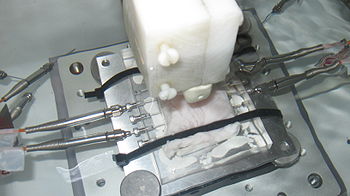
Figure 3 - The housing placed in the water bath with a clear view of the thermocouples
